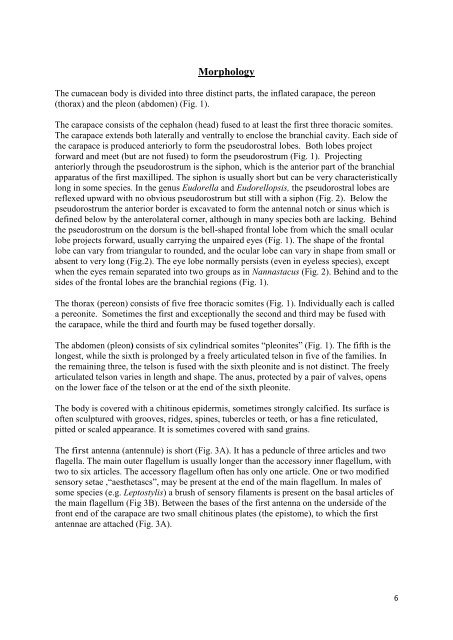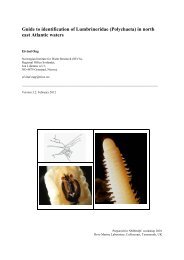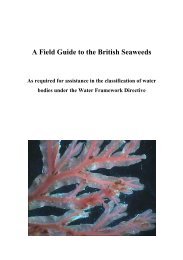You also want an ePaper? Increase the reach of your titles
YUMPU automatically turns print PDFs into web optimized ePapers that Google loves.
Morphology<br />
The cumacean body is divided into three distinct parts, the inflated carapace, the pereon<br />
(thorax) and the pleon (abdomen) (Fig. 1).<br />
The carapace consists of the cephalon (head) fused to at least the first three thoracic somites.<br />
The carapace extends both laterally and ventrally to enclose the branchial cavity. Each side of<br />
the carapace is produced anteriorly to form the pseudorostral lobes. Both lobes project<br />
forward and meet (but are not fused) to form the pseudorostrum (Fig. 1). Projecting<br />
anteriorly through the pseudorostrum is the siphon, which is the anterior part of the branchial<br />
apparatus of the first maxilliped. The siphon is usually short but can be very characteristically<br />
long in some species. In the genus Eudorella and Eudorellopsis, the pseudorostral lobes are<br />
reflexed upward with no obvious pseudorostrum but still with a siphon (Fig. 2). Below the<br />
pseudorostrum the anterior border is excavated to form the antennal notch or sinus which is<br />
defined below by the anterolateral corner, although in many species both are lacking. Behind<br />
the pseudorostrum on the dorsum is the bell-shaped frontal lobe from which the small ocular<br />
lobe projects forward, usually carrying the unpaired eyes (Fig. 1). The shape of the frontal<br />
lobe can vary from triangular to rounded, and the ocular lobe can vary in shape from small or<br />
absent to very long (Fig.2). The eye lobe normally persists (even in eyeless species), except<br />
when the eyes remain separated into two groups as in Nannastacus (Fig. 2). Behind and to the<br />
sides of the frontal lobes are the branchial regions (Fig. 1).<br />
The thorax (pereon) consists of five free thoracic somites (Fig. 1). Individually each is called<br />
a pereonite. Sometimes the first and exceptionally the second and third may be fused with<br />
the carapace, while the third and fourth may be fused together dorsally.<br />
The abdomen (pleon) consists of six cylindrical somites “pleonites” (Fig. 1). The fifth is the<br />
longest, while the sixth is prolonged by a freely articulated telson in five of the families. In<br />
the remaining three, the telson is fused with the sixth pleonite and is not distinct. The freely<br />
articulated telson varies in length and shape. The anus, protected by a pair of valves, opens<br />
on the lower face of the telson or at the end of the sixth pleonite.<br />
The body is covered with a chitinous epidermis, sometimes strongly calcified. Its surface is<br />
often sculptured with grooves, ridges, spines, tubercles or teeth, or has a fine reticulated,<br />
pitted or scaled appearance. It is sometimes covered with sand grains.<br />
The first antenna (antennule) is short (Fig. 3A). It has a peduncle of three articles and two<br />
flagella. The main outer flagellum is usually longer than the accessory inner flagellum, with<br />
two to six articles. The accessory flagellum often has only one article. One or two modified<br />
sensory setae ,“aesthetascs”, may be present at the end of the main flagellum. In males of<br />
some species (e.g. Leptostylis) a brush of sensory filaments is present on the basal articles of<br />
the main flagellum (Fig 3B). Between the bases of the first antenna on the underside of the<br />
front end of the carapace are two small chitinous plates (the epistome), to which the first<br />
antennae are attached (Fig. 3A).<br />
6




